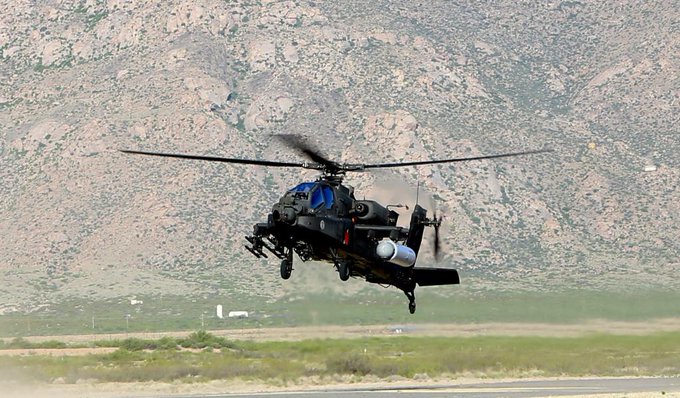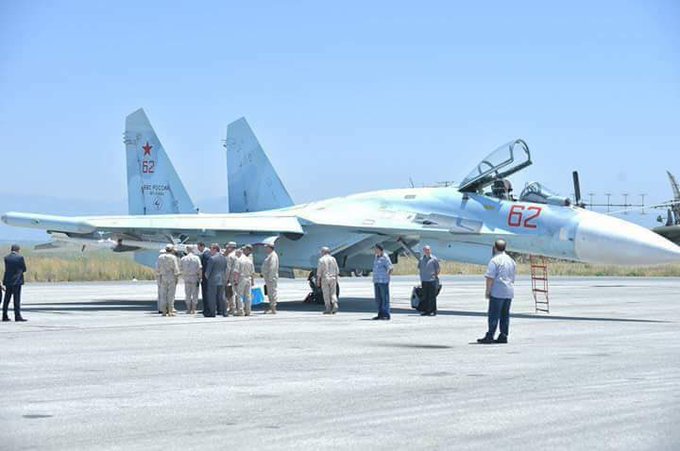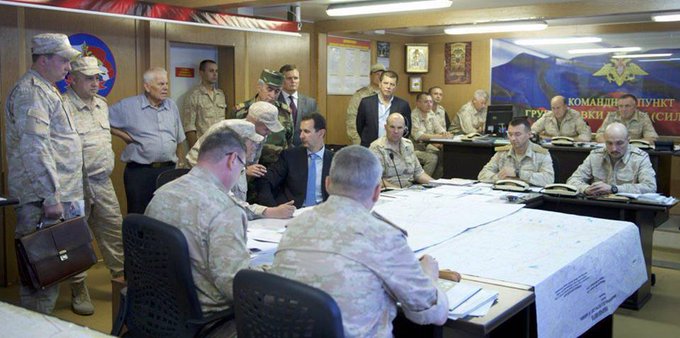Michael Horowitz Retweeted
Turkish Minute @TurkishMinuteTM 11m11 minutes ago
Erdoğan says Turkey ready for new operation in Syria http://buff.ly/2uilzzp
posted for fair use and discussion
https://www.turkishminute.com/2017/...al&utm_source=twitter.com&utm_campaign=buffer
Erdoğan says Turkey ready for new operation in Syria
By
TM -
June 28, 2017
ISTANBUL, TURKEY - JUNE 25 : President of Turkey Recep Tayyip Erdogan gestures as he speaks within "Istanbul Exchanges Greetings" event organised by AK Party's Istanbul Province Branch during Eid al-Fitr in Istanbul, Turkey on June 25, 2017. Eid-al-Fitr is a holiday celebrated by Muslims worldwide that marks the end of Muslims' holy month of fasting "Ramadan". AFP
Turkish President Recep Tayyip Erdoğan said on Wednesday that Ankara is ready to undertake a new military operation in northern Syria similar to Operation Euphrates Shield, which was launched in August of last year.
Speaking to the Russian Izvestia newspaper, Erdoğan said Turkey’s borders are under threat by Syrian Kurdish militia and that Turkey would not allow the establishment of any Kurdish state in Syria, Sputnik reported.
“Presently, negative processes are under way in Syria. In the event they lead to a threat to our borders, we will respond in the same way as during Euphrates Shield. Turkey will not allow the establishment of a Kurdish state in Syria and is ready to carry out another large-scale military campaign if needed,” he said.
In late March Turkish Prime Minister Binali Yıldırım announced that Turkey had successfully completed its Operation Euphrates Shield in Syria.
During the operation, Turkey and Kurdish People’s Protection Units (YPG) forces were involved in clashes that caused tension with the US, which considers the YPG a close ally in the fight against the Islamic State in Iraq and the Levant (ISIL), while Turkey considers it a terrorist group due to its links with the outlawed Kurdistan Workers’ Party (PKK).
Turkish military: Turkey returns fire on YPG in northern Syria
Meanwhile, Turkish armed forces retaliated with artillery fire overnight and destroyed YPG targets after Kurdish militia opened fire on Turkish-backed forces in northern Syria, the Turkish military said on Wednesday.
According to a Hürriyet Daily News story, the army said YPG machine-gun fire targeted Turkish-backed Free Syrian Army (FSA) elements in the Maranaz area south of the town of Azaz in northern Syria on Tuesday night.
“Fire support vehicles in the region were used to retaliate in kind against the harassing fire and the identified targets were destroyed/neutralized,” the military statement said.
Michael Horowitz Retweeted
Charles ListerVerified account @Charles_Lister 3h3 hours ago
Replying to @Charles_Lister @faysalitani and
.@FredericHof with a necessary & strong warning:
- In #Syria, #Trump is Letting #Iran & #Assad Win
http://www.newsweek.com/syria-trump-letting-iran-and-assad-win-629380 …
Michael Horowitz Retweeted
Matthew Schweitzer @PostWarWatch 24m24 minutes ago
ICYMI: @AlexMello02 explains why #UAE is expanding in E #Africa, part of its #Yemen war. A fascinating conversation:
posted for fair use and discussion
https://postwarwatch.com/2017/06/26/beyond-the-peninsula/
Beyond the Peninsula
ALEX MELLO — The United Arab Emirates’ rapid expansion into East Africa will permanently reshape the region.
Over the past decade, the UAE has become increasingly assertive in its foreign policy, breaking from a tradition of regional neutrality. Since the Arab Spring, Abu Dhabi has, most notably, joined the Saudi-led coalition in Yemen, participated in the fight against ISIS in Iraq and Syria, and deepened engagement in Libya. Why has the UAE sought to practice a more activist foreign policy – are Abu Dhabi’s policies today truly a departure from its historical foreign policymaking?
The war in Yemen since 2015 has been the main driver of the UAE’s activist foreign policy and power projection in the Horn of Africa and East African coast. In the summer of 2015 Emirati planners needed to deploy fairly large conventional forces – around two brigade-sized task forces – into Yemen and sustain these forces logistically once they were in-country. The UAE government was aware that it would be unable to rely entirely on the US for these services – a realization that prompted a crash program of Emirati base building in places like Eritrea and across the Horn of Africa. Underlying these developments was a perception in Abu Dhabi that Washington was in the process of disengaging from the Middle East region between 2009-2013, beginning with the Obama Administration’s push to complete the Joint Comprehensive Plan of Action (JCPOA) nuclear agreement with Iran. This perception of US disengagement and inaction drove, in part, the Arab Gulf countries’ combined intervention in Yemen, ultimately sparking the energetic UAE power projection drive that’s now being exhibited.
As Abu Dhabi assumed a leading role in the Saudi-led coalition in Yemen, Emirati planners faced some huge logistical challenges. However, Abu Dhabi’s demonstrated capabilities have been impressive. The UAE first deployed large ground forces into the southern Yemeni port city of Aden in August 2015. This operation – the amphibious insertion of a brigade-sized battlegroup into a Special Forces-developed pocket in Aden and the subsequent armored breakout north from Aden city – was quite impressive in terms of its scale and professionalism. Such a complex operation is logistically very challenging for any military – especially for the UAE, which had to transport these forces to a battlefield approximately 1,000 miles from the Emirati homeland. By comparison, most NATO countries aside from potentially France and the UK would be hard-pressed to pull off a similar intervention without any US support.
It’s key to remember that the UAE was able to successfully complete this operation without any significant American air or naval support. Emirati commanders have subsequently said that their US Central Command (CENTCOM) counterparts had very little idea about what the UAE was doing in Aden; American military planners were quite surprised at Abu Dhabi’s ability to complete the Aden operation. The UAE military’s successful conduct of the Aden operation and subsequent operations in Ma’rib, likely demonstrated to planners in Abu Dhabi that they could independently conduct large, complex expeditionary operations in Yemen, and potentially other places in the region, thus giving rise to the more ambitious power-projection mindset in Abu Dhabi today.
In 2015, Saudi Arabia led a coalition of nine Arab states to war in Yemen to support the government of President Abdrabbuh Mansur Hadi. Abu Dhabi was a critical and seemingly enthusiastic member to this expedition. What factors influenced the UAE’s decision to join this coalition – did it enter the conflict with the same goals as outlined by Saudi leadership?
When the Saudi-led coalition’s intervention in Yemen began in March 2015, the aims of its member countries were more closely aligned than they are now. The operation was initially simple and urgent: stop the Houthi rebel forces – which had swept into the Yemeni capital, Sana’a, in September 2014 and sought to depose the internationally-recognized government under President Abdrabbuh Mansour Hadi – from overrunning all of southern Yemen and seizing critical cities like Aden and Taiz. Initially, the coalition attempted to achieve these goals using airpower, but eventually were forced to insert ground forces. Until this escalation point, the UAE and Saudi Arabia aims were very closely aligned.
(See here for more details about the causes of and actors in Yemen’s war.)
As the UAE started putting boots on the ground, however, Abu Dhabi’s goals began to diverge slightly from those pursued by Riyadh. At this point, too, there was a growing delineation of spheres of influence across Yemen: The UAE took a leading role in southern coastal areas in Aden and Abyan, while the Saudis operated further north in places like Ma’arib. These divisions ultimately precipitated a wider divergence of Emirati and Saudi goals over the following year of fighting. Today, the UAE is not terribly keen on putting the Hadi government back into power, which is a core Saudi objective – though I think there is a sense that the Saudis themselves are getting impatient with Hadi. Abu Dhabi views Hadi’s government as ineffectual, and is not convinced that it could ever return to Sana’a.
Instead, the UAE has focused its efforts on building a what amounts to a sphere of influence in southern Yemen through infrastructure projects, humanitarian aid, and small, limited deployments of ground forces. By having actual boots on ground, the Emirati have been able to work with a range of local militias under the umbrella of the Yemeni Southern Resistance movement, which advocates for autonomy and a secular republic in southern Yemen. Meanwhile, the Saudis are still more focused on maintaining a united Yemen under President Hadi’s government. The Saudi leadership have also been far more willing to tolerate Islamist factions in central Yemen, whereas the UAE is deeply suspicious of these groups.
The state of cooperation between Saudi and Emirati-backed forces has deteriorated over the past six months as a result of these divergent goals. The first significant clash between the Hadi government and Southern Resistance forces occurred in February 2017, regarding the status of Aden’s international airport. The Hadi government’s Presidential Protection Force – commanded by Hadi’s son – attempted to seize the airport from the Aden Security Belt forces, an Emirati-developed security force for Aden. Fighting continued for several days, with the UAE providing air support for their allies against the Hadi-aligned units. After the fighting President Hadi and his son flew to Abu Dhabi for joint talks with the Emirati and Saudi leaders, which were ultimately inconclusive. Between April-June, tensions in Aden have remained high, with three outbreaks of fighting for control over Aden’s airport. In May, President Hadi hit back by dismissing Aden’s provincial governor, a very popular UAE-backed Southern Resistance figure.
Today, the situation in Aden is very dangerous. It is unclear how – or if – these tensions can be resolved. Leaving this situation unresolved will likely in the long-run end up leading to greater autonomy for the Southern Resistance movement. The UAE has a footprint on the ground in Aden and across southern Yemen, supporting its local partners and building influence there. The Hadi government, on the other hand, does not receive the same sort of backing from the Saudis, and thus has far fewer resources with which to assert his control.
Within the context of the Saudi-led war in Yemen, the UAE has spearheaded operations in southern and eastern Yemen against Al Qaeda in the Arabian Peninsula (AQAP). How has the UAE shaped its counter-insurgency campaign against AQAP, particularly in terms of building local coalitions and financing train-and-equip programs?
Quite a bit of long-term planning went into this counterinsurgency effort. For example, nine months before UAE-backed forces moved into AQAP territory around the city of Mukalla in coastal Hadramawt Governorate, the UAE began recruiting local tribal fighters and shipping them to the Emirati base at Assab, Eritrea. There, the UAE military could conduct large-scale training – maneuvering of company and battalion-sized mobile infantry units – without any interference. When these forces were re-inserted into Yemen, they fought alongside embedded UAE Special Forces and a small Emirati conventional ground force. Though not perfect they performed fairly well – the aim was to develop local forces that were “good enough” to complete their immediate missions without trying to build them into clones of the UAE military.
Concurrent to military-based counterinsurgency operations, the UAE has engaged in a range of reconstruction and development projects, providing electricity generators, re-opening schools and supplying humanitarian aid. One of the UAE’s telecommunications providers rapidly established cellphone coverage in southern Yemen. Ultimately, these counter-insurgency efforts have not been completely successful. Emirati forces are small in number and spread very thinly on the ground; the effort of training and supporting local forces to hold large swathes of territory from AQAP appears to be overstretching the UAE’s resources.
Initially, the UAE achieved success in its counterinsurgency operations largely due to its focus on clearing AQAP from major urban areas in the region. Before the UAE intervention, AQAP held huge areas in southeastern Yemen, including Mukalla and a number of other cities in Abyan Governorate, just east of Aden. The UAE task force was inserted to rapidly clear these cities and towns and then moved out again with aim of not getting bogged down in prolonged ground operations, and sustaining heavy casualties – that the Emirati armed forces, which are quiet a small, compact professional force can’t really afford. While Emirati forces and their local allies cleared insurgents from the urban areas very rapidly, they’ve had more difficulty transitioning to static security operations in rural, low-population operations.
Emirati and local forces have struggled in this new environment of open-ended counterinsurgency, largely due to insufficient resourcing. Training, equipping, and sustaining the forces necessary to maintain security these areas has proven much more challenging than the first phase of the UAE’s battle against AQAP. For example, the UAE has trained a number of small, local “security belt” forces to hold towns across southern Yemen, but these units have been handicapped by insufficient weapons, emerging tribal splits, and lack of continuous funding.
Since operations against AQAP kicked off in early 2015, the UAE has attempted to avoid precisely the kind of open-ended rural counterinsurgency in which it is now engaged. Since 2015, US support has been focused mostly on the kinetic end of the spectrum: counterterrorism raids, conducting drone strikes against AQAP targets, and providing intelligence assets. It is far less clear whether Washington will provide any support to local UAE and Yemeni forces in terms of development or counterterrorism. For example, the Governor of Hadramawt commented in a Foreign Policy article that AQAP could only be defeated with more local-level counter-terrorism, intelligence, and development aid. In the future, it will be important to see whether the UAE and their local partners receive any more support from the US to support these types of operations.
In recent years, the UAE has sought to build up its military presence in East Africa, most notably through its 2015 acquisition of the deep-sea port and airbase at Assab in Eritrea following a breakdown in relations with neighboring Djibouti. How does the Assab base development fit into the context of the UAE’s growing footprint in East Africa, Horn of Africa, and Indian Ocean – has its development shifted the UAE’s strategic footprint in the region?
The speed with which the UAE managed to acquire its Assab base after losing access to another location in Djibouti is extremely impressive. It took Abu Dhabi only three weeks to secure Assab, and the scale of the base’s subsequent development in 2015 surprised many analysts. The UAE was already flying Mirage fighter jets out of Assab in early May, some six weeks after the start of the Gulf coalition air campaign in Yemen. The Assab base has been vital to the UAE’s entire operation in Yemen, serving as the key transshipment hub for troops and materiel destined for southern Yemen.
Since that period of rapid development, Abu Dhabi has used the Assab base to sustain its entire military operation in Yemen. As a result of conducting as a result of independently conducting these long-range expeditionary operations for the first time, Emirati policymakers have come to appreciate the critical importance of the Bab al-Mandeb and Indian Ocean sea-lanes for the UAE, not only in terms of sustaining its operations in Yemen but also for the federation as a whole. For example, these sea-lanes are critical for maintaining the port in Jebel Ali, near Dubai, as they key Middle East logistics and trade hub. From this understanding emerged a new phase of Emirati expansion and power projection. The UAE is constructing a new airfield and naval facility on Yemen’s Perim Island, directly on the Bab al-Mandeb between Eritrea and Djibouti. It is also developing a number of bases or forward operating locations along the southern Yemeni coast and Socotra Island. Across the Bab al-Mandeb Straits in the Horn of Africa, the UAE’s Dubai Ports World also operates a major port in Berbera, just across the Gulf of Aden from Yemen in Somaliland, and has begun to develop an airfield and naval base there. P&O, another Emirati port operator, also won a contract to develop a port in in northeastern Somalia’s Puntland region.
map at link halfway down:
https://postwarwatch.com/2017/06/26/beyond-the-peninsula/
Taking a wider look along the East African coast, Abu Dhabi has sought to expand its footprint in many of the Indian Ocean island-states – most notably in the Maldives and Seychelles. Until a few years ago, this process was largely defined by trade, private investments and development aid. Yet, the Yemen War has emphasized the security benefits gained through such power-projection. For example, the UAE provides funding, training and support for the Seychelles Coast Guard – in 2011 they built a new coast guard base on an artificial island development funded by Abu Dhabi in Mahé and donated a number of patrol boats. The Emirati navy also regularly calls there. The UAE also provides training and support for the Puntland region of Somalia’s Maritime Police Force, which assist in interdicting smuggled Iranian weapons destined for Yemen through the Horn of Africa. Ultimately, these bases represent the initial stages of larger, deliberate UAE policy of power-projection across the East Africa region that will continue into the future.
As Abu Dhabi expands its footprint in East Africa, it has become embroiled in regional conflicts. Who are the UAE’s main competitors in its push to expand its footprint in East Africa – how have Emirati actions impacted relations between regional actors like Djibouti, Eritrea, or Ethiopia?
The UAE’s economic interests in the region predate the outbreak of conflict in Yemen. For example, the UAE owns large tracts of land in East Africa as part of its food security policy. Yet, it has only been in the past two years as a result of the war in Yemen that Abu Dhabi deepened its engagement across East Africa and the Horn of Africa. The base at Assab base was set up rapidly in 2015 to meet an immediate military necessity. Today, policymakers in the UAE are moving more deliberately, with an eye on balancing their relationships in the region and the potential repercussions of high-visibility UAE expansion.
For example, when the regional Somaliland parliament voted to approve the UAE base at Berbera, there was significant protest from the Somali federal government that the base deal had been conducted without its approval. This case is interesting because Somalia also receives a great deal of security assistance from the UAE, including train and equip program run from a base in Mogadishu. In addition, as part of the Berbera base agreement, the UAE plans to build a highway corridor between Somaliland and landlocked Ethiopia. Currently, almost everything that goes into or out of Ethiopia – the region’s largest and fastest growing economy – has to go through the port terminal at Djibouti; if the highway is finished, the Djibouti port – which is also run by DP World – may end up having problems competing economically.
The UAE’s East Africa policies today represent a new phase of Emirati “hard power” projection compared to the “soft power”, development aid and investments-centric approach of the last decade. Balancing competing regional interests is going to be increasingly challenging for policymakers in Abu Dhabi as they pursue this expansion. They are trying to be friends with every actor – and they have achieved some successes, most notably the quick turnaround with Assab in 2015. Yet, moving forward, the UAE will face many challenges achieving its “zero problems with neighbors” goal in East Africa and the Horn, despite its financial muscle and newfound influence as provider of regional security assistance.

 Raytheon
Raytheon





